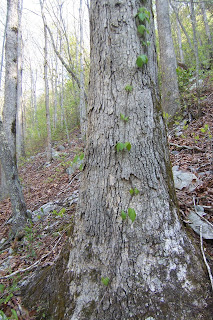From Jay:
I have both observed and experienced several near misses with doom. Disaster, as defined by a thru-hiker, is any mishap that results in premature termination of the hike. These "showstoppers" strike swiftly, out of the blue, when you least expect them. While researching the AT, one is duly warned about the most popular and sexy showstoppers such as getting mauled and/or eaten by a bear, getting murdered by some wacko, or simply disappearing for undetermined reasons. (lost? abducted? fell off a cliff? went to Jamaica instead?)
 |
| Looking up a rough, steep trail |
The near misses I have personally experienced could have been just as effective as the popular showstoppers, but I'm afraid they were much less glamorous. Those which I will impart on this blog include: belly flop on a solid medium, self-inflicted conflagration, lemming imitation, and, last but not least, David and Goliath.
Belly Flops: We've all done them, usually unintentionally, off a diving board. They are not pleasant for the participant, but are strangely comical to observe. The sequence of events usually progresses from a confident strut down the board, followed by an enthusiastic leap to gain maximum height and perfect horizontal attitude, followed by a mid-air stall which locks the participant into this splayed position while the force vector changes from out to down, followed by a pitifully un-streamlined entry into the aqueous media. The collision between belly and water can be spectacular, producing a delightful noise, impressive splash and entertaining sounds and motions from the participant.
Now imagine a young but sadly overweight male hiker, staggering up a hill in the woods, toting a 50 lb pack. He employs trekking poles to aid his climb. These telescopic sharp metal sticks are strapped to each wrist of many hikers these days. They are as great an assistance as 4 wheel drive is in going up hills and in slowing descents as well. They counteract the downward force generated by the heavy pack and distribute the work to the shoulders and triceps instead of the knees.
The heavily burdened rotund young man finally tops the rise and begins his descent. Like a roller coaster he gradually picks up speed as the grade steepens. Unfortunately the novice hiker decides during the ensuing acceleration to adjust the length of his trekking poles. He goes on autopilot, takes his eyes off the trail, and disassembles his right pole, exposing several sharp tube rims that are usually tucked away while the poles are in use.
 |
| Water Bar diagram |
Water bars are both loved and hated by hikers. They are installed in the tread of the trail on slopes to deflect water. They prevent the trails from becoming streams during rainstorms and snowmelt. The water is deflected by the water bar, which looks like a miniature diagonal dam, off the downhill side of the trail. They also serve as slight obstacles to the hiker, who must step over them if he wishes to avoid tripping or prevent a painful toe stub. A launch pad helps to maximize the hiker's speed, while a slight depression increases the probability of abrupt toe contact with a launcher. The launcher may be made of wood, rock or metal, and is often securely installed to prevent an cushioning effect to the toe of the hiker. The landing area is immediately downhill from the launcher and can incorporate rocks, slabs, or even stairs to make the landing more memorable.
Eyes diverted from the tread, our hapless hefty hiker kitters forward as his left foot hits the depressed launch pad. He desperately swings his right leg forward to counter-balance, but the motion is abruptly thwarted by the launcher which, in this case, is made of rock slabs. Take-off is successful; the splayed horizontal attitude is achieved. Fortunately our aeronaut possesses the composure and skill needed to eject his trekking pole pieces on his way down. He sticks the landing almost perfectly on the fortunately benign landing area. The sound resembles that which one would expect to be produced by a collision between a tour bus and an adult water buffalo.
The hiker remains motionless, face down, pinned between his pack and the trail. Soon a moaning sound is emitted. The hiker gradually squirms into a kneeling position. "I think I broke my arm," he moans. Remaining on his knees, he gingerly tests his range of motion as he breathes, "Thank you, Jesus, for not letting me break my arm," several times. His friend, approaching from behind, proclaims, "I'll give that one an 8."








































